Derelict Dreams
An Illustrated Novel by Steve Patchin
Derelict Dreams is an illustrated novel that takes place in Las Vegas. It follows two young sisters on a harrowing journey through the city in a British double decker bus, while giant, decaying, advertising signs walk among the hotels and casinos, and horrific gangs force the end of civilization. Why are the signs here? Can the girls survive? Will anything remain worth living for?
Derelict Dreams comes in three editions: the full color, large edition with more than 80 photographic quality images, and a smaller, standard novel-size edition in black and white, and an eBook edition. For the full experience, we highly recommend the full color hardback.
11 x 8.5 color hardback edition $49.95 AVAILABLE NOW.
8.5 x 5 paperback edition: $14.95 AVAILABLE NOW.
Shop for Derelict Dreams Here.
This is Steve’s first novel, and it’s based on his artwork. The large edition is a novel and an art book in one.
Excerpts and Examples:
The signs tore themselves from their old buildings that had held them for decades. They ripped free from their pointless vigils, no longer advertising anything that existed. They pulled, clawed, and crawled, using appendages that broke through from their constructs. Like sprouting weeds in empty lots, they gathered in odd places. Many grew huge, and glowed to life as if connected to some invisible power source. And then, they set out, in isolated herds, or as loners, heading south. They trekked through streets and deserts, across snow and over mountains. In some places, old classic cars traveled with them, driverless. There was no obvious explanation for how these behemoths were walking like animals, or how they even existed in the first place.
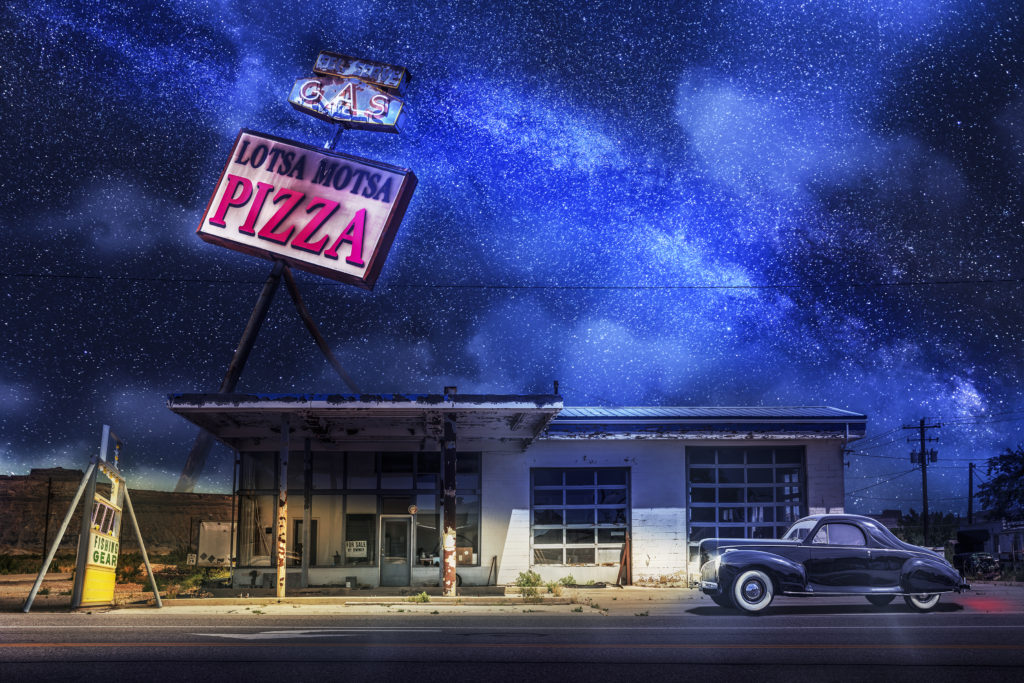
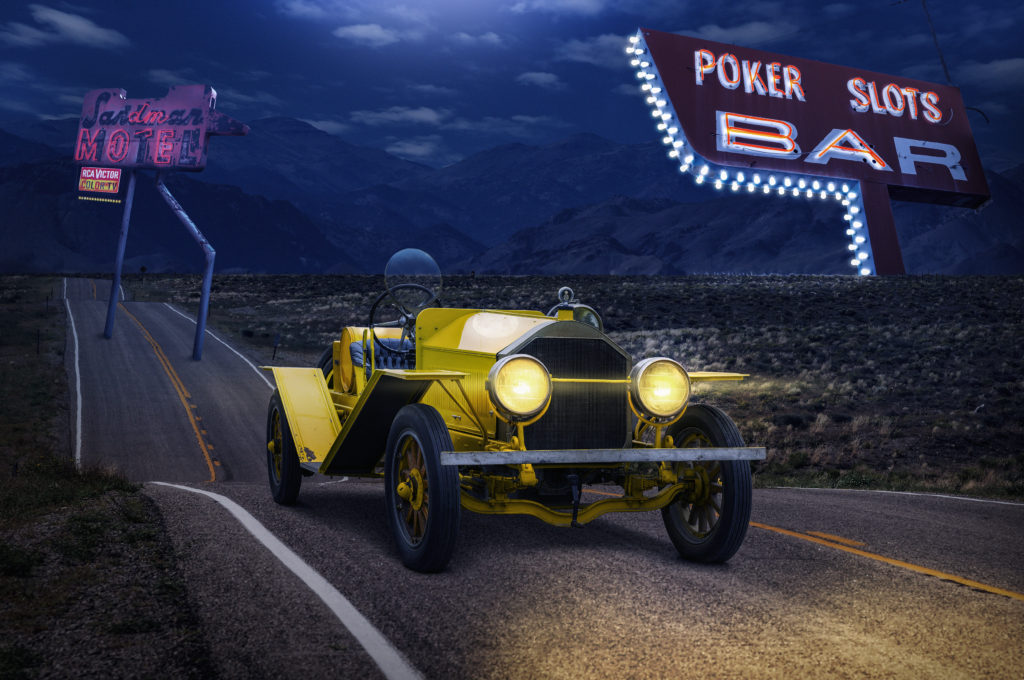
As we drove in the bus down the empty freeway toward Las Vegas, we saw the flickerings of small fires sparsely scattered around the valley. Survivors? Had the fighting stopped? Were the gangs in gas masks still hunting people?
Vegas was built to be an illuminated jewel in the desert, but instead it looked like a line of stacked poker chips, discarded, sun-faded, and worthless. The shadowy buildings in the deepening dusk seemed lost. The sparkling lights from homes and businesses that used to glow throughout the valley were gone.
The spring air outside felt warmer than it had when we left the mountain. I stood behind the driver compartment of the bus, hanging onto the handrail. Seeing my reflection in the rearview mirror, I felt as if the person who stared back looked more like my mom than what I remembered of myself before all this happened. I was only twelve now. My dirty blonde hair hung below my shoulders, and my cheeks were fuller, even after surviving with minimal food for a year. I missed my mom, but I’d also learned to grow up fast.
We’d hidden in the high desert mountains for a long time. In the winter, we got dustings of snow even though we were among Yucca trees. In the summer, the smell of sage and juniper saturated the air, especially when it rained and lightning danced over the mountains. Las Vegas was just over the hill to the south, but we almost never saw anyone. We had been lucky to find a place to hide the bus. Its second deck was a big problem, looming red over the natural features of the desert, but the dirt road dipped down enough, along a wash, to hide us from Lee Canyon Road and whoever might drive up to the ski resort on the mountain, not that it would be open. With so few people left anyway, we hadn’t expected anyone up there. Still, we had to be careful.
At night in the summer, the Milky Way was brighter than what was left of the glare from Las Vegas. The city’s glow on the horizon diminished over time until the stars stole back the yellow haze and replaced it with their own crisp flickering of blue and red above the mountains.
We knew we had to go back eventually, but we pretended it was always in the future. With the dried food and canned food gone, and not much water remaining from the melted snow in the bus’s tanks, the future had caught up to us. And so had the past. We couldn’t put off going back any longer. Time to face whatever was left of Las Vegas and see if civilization still existed.
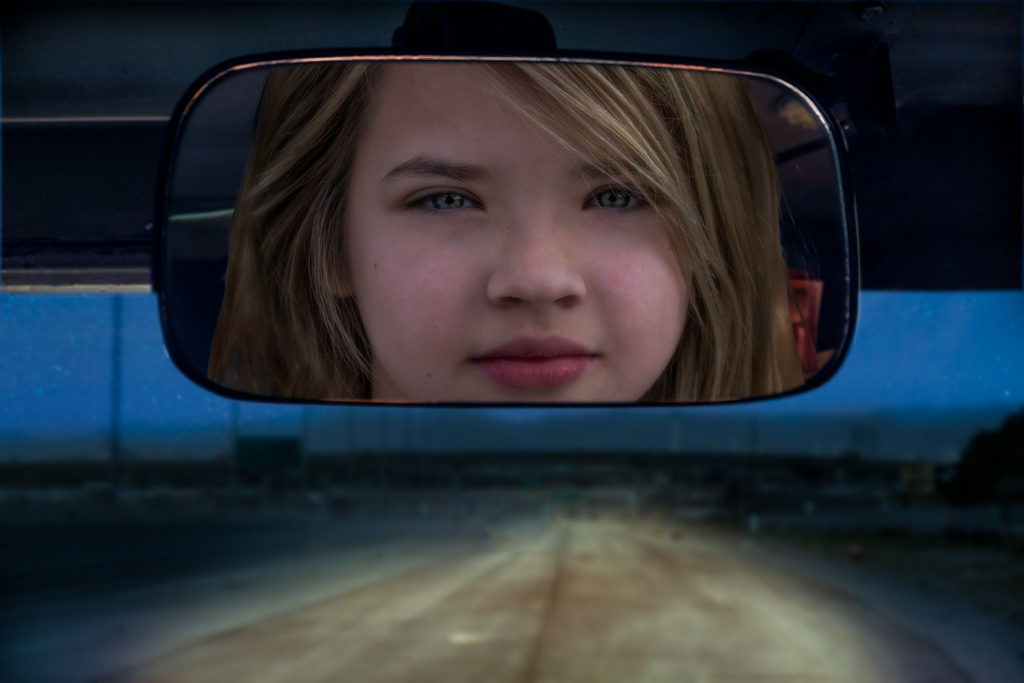
Many months before the Threat had thrown Vegas into ruin, along with the whole country, we had started seeing out-of-place, old advertising signs and classic cars appearing around the city in odd locations. Someone must have seen them moving along the empty highways that snake toward Vegas. We came to believe they were from old buildings throughout the west. But we never heard about them before we saw one ourselves. We didn’t know they would have anything to do with the eventual death of our city.
Before all this, when schools were still open, we had seen the red bus for the first time. This was before everything shut down. We followed another walking sign a few days after we had seen the first one. This sign was bigger than the first, maybe the size of a horse, and read “Beer.” It was a cold day for Vegas, and unusual too, because it started snowing. Sis never got cold, and was wearing only a dress, which seemed to be perfectly comfortable to her, as usual. We were supposed to be headed for the school bus stop, but we couldn’t let this sign disappear.
“Let’s get it,” Sis said.
“Yeah.”
It “walked” with the poles and sticks it was attached to swinging awkwardly around it. The “Beer” part of the sign glowed in yellow. It went past the hedges and around a fence into the parking lot by the park. Strange, purple clouds curled in the distance. The bus stood out, red and tall, like the ones in British movies. It had paintings and writing on it that was scratched and faded. I saw the words, “art” and “coffee” a few times. From a distance, the exhaust smelled like the tractors that were digging up the road by the shopping center. The beer sign stopped moving near the bus. As we got closer, I smelled coffee brewing, just like at our house in the morning.
We stood looking at the bus for a moment, the wild artwork on its sides. Some of it was landscapes that twisted into other pictures with trees and even a metal face. Sis walked around to the entrance on the other side and just got on, as though it were the natural thing to do.
“Wait,” I said, too late. I paused, and then followed her anyway. “What are you doing?”
“It’s okay,” she said as I stepped onto the bus too. “This is really cool.”
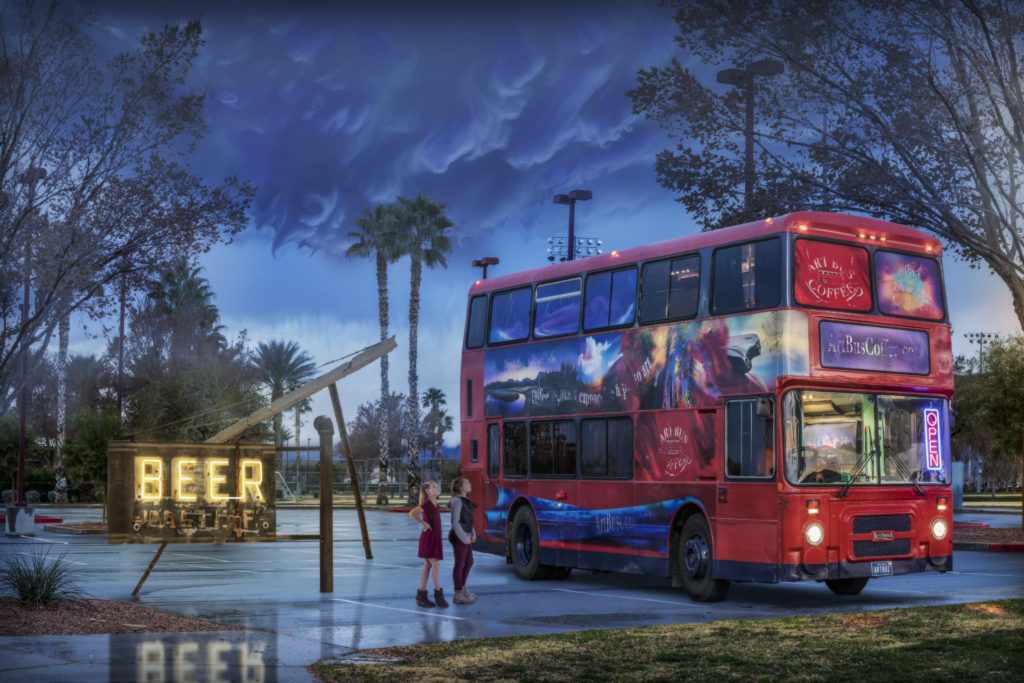
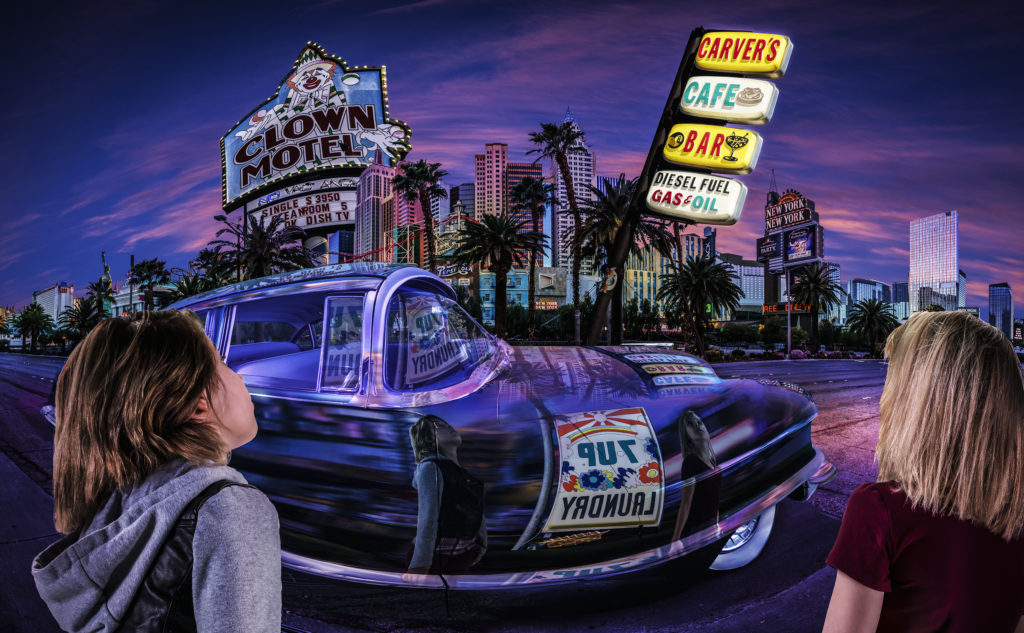
I was already having lots of dreams at night while I sweated with sheets twisted around me. Seeing the gangs outside made it worse. One dream was even stranger than the one I’d had about the tentacles at the 7-Eleven. A rumbling rolled along the road in the distance and up through our feet. Sis and I stood at the end of the Strip, hotels crumbling and melting, a hot fire barreling forward from downtown, twisting through the destruction, the Las Vegas sign floating upward and dripping. We walked toward the orange heat as if it were normal. The new normal. That was a term I had heard a lot as things had gotten worse. People on picture chat sites were saying we had to get used to things not being the same as before, the new normal. I guess they were right; things would not be the same again. But I didn’t want to keep walking toward this “new normal.” Why were we walking toward this? It made no sense. I wanted to stop, grab Sis, and turn back. But we kept walking, the heat getting worse, starting to melt us.

Sign up for updates or check back here to find out the exact release date in December, 2020.
Shop for Derelict Dreams here.
About the Author/Artist, Steve Patchin
Steve Patchin is a photographer and artist who has been working and running a studio in Las Vegas, Nevada for more than 23 years. Derelict Dreams is his first novel, and his art was the inspiration for the novel. That’s why the novel is also an art book, with more than 80 detailed images. When making his impressionistic images, he uses a production approach that involves an intense focus on detail, with layering and compositing that build depth, whether the end result is simple or complex. Steve is a Las Vegas native with an extensive portfolio of photographic images, realistic composites, and impressionistic paintings. He has owned and operated his photography and video business, Patchin Pictures, since 1997, winning eight Emmys for his work. He also owns and operates Art Bus Coffee, a unique mobile coffee shop and art gallery where he displays some of his artwork. Steve has never stopped expanding and refining his art and photography. His resume of images displays an abundance of styles and subjects that are uniquely appealing, from traditional landscapes and cityscapes to his distinctive “photo paintings” that are more impressionistic, sometimes surreal, or other-worldly. One of Steve’s big art-related projects is Art Bus Coffee, a business he started in 2017. It is a mobile coffee shop and art gallery in an English double decker bus. While researching ideas for presenting art to the public so more people can experience it, Steve realized that the best way to reach more people would be to take the art to them. That’s where the idea, and thus the business, began. Seeing actual, physical art in person is very different from looking at it on a computer screen or a phone, but how can people know this if they haven’t experienced the difference? And shuffling through an art gallery isn’t always convenient or appealing. The access to art needs to be easy, and people need time to relax and enjoy it. Thus, Steve designed Art Bus Coffee so he could bring the art directly to people, and they could get an espresso, go up to the second level of the bus, and relax among the artwork. Steve says, “The satisfaction of tasting a good cup of coffee or espresso is very much like the satisfaction of seeing good works of art: they both feel right. And what better way to do both at the same time than having a coffee and experiencing art on a classic, English, double decker bus?” The positive response from people seeing and buying Steve’s more stylized artwork has been surprising even to Steve. “I create pictures that interest me, making stylish changes to, and blending, my original photos in order to reveal the feelings, ideas and stories I would want to display on my walls,” says Steve. “Making connections with others by holding true to what feels right to me. In this, art and life become the same thing.”



